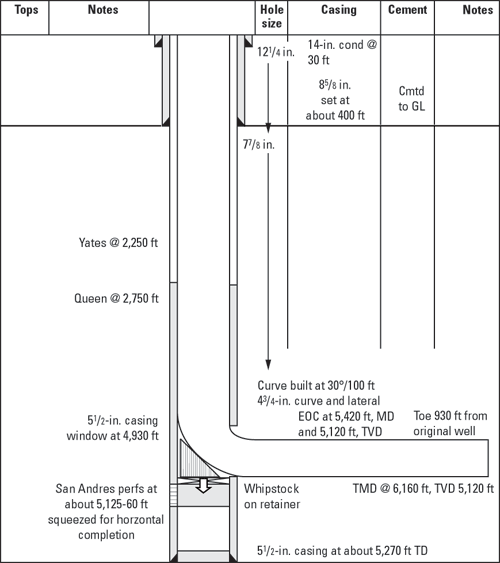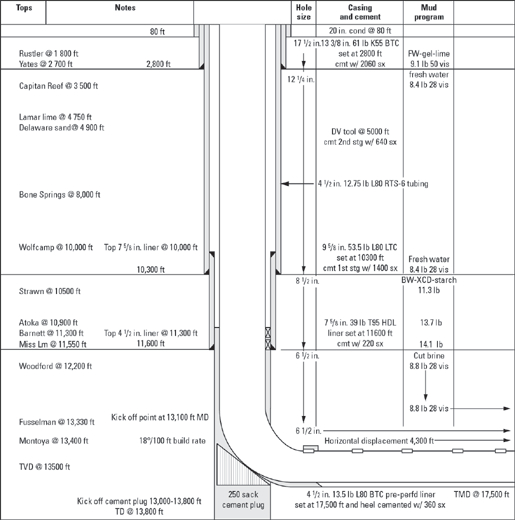|
|
|

By Petroleum Technology Transfer Council |
Permian basin operators refine horizontal drilling techniques
Operators in West Texas and Southeastern New Mexico have had good commercial success adapting horizontal drilling to specific Permian basin reservoir conditions.
Mike Cure, XACT Technologies, Inc., Midland, Texas
Horizontal wells have been a significant portion of Permian basin drilling and completion activity for the past decade. In February 2005, there were about 18 horizontal wells drilling in the Permian basin of West Texas and southeastern New Mexico, with half being newly drilled wells and half being sidetracks from existing wells. Summary information from state regulatory commission filings indicates 818 active horizontal wells in the basin, with 669 in Texas and 149 in New Mexico. Two-thirds of West Texas counties and all New Mexico counties in the basin have horizontal wells.
Although horizontal drilling and completion work is frequently kept confidential by operating companies, considerable general information is available from public domain and other legitimate sources. Most Permian basin horizontal laterals are drilled in carbonates, as opposed to sandstones or shales. The carbonates selected for horizontal completions fall into two very different categories of rock type and reservoir – the good permeability zones and the very low-permeability tight zones. The reasons for drilling specific horizontal wells in the basin are as varied as the operators.
GOING HORIZONTAL IN GOOD-PERM RESERVOIRS
In good-permeability zones, the primary reasons for horizontal completions are to control water and gas coning, or to improve lateral sweep efficiency in waterfloods and carbon dioxide floods. Horizontal completions have been implemented in both oil and gas fields with good permeability, Fig. 1.
 |
Fig. 1. Typical good permeability completion in the Permian basin.
|
|
Horizontal wells have been advantageous in several fields characterized by high vertical permeability. The traditional vertical completion in these fields tended to cone water up and/or gas down, due to the strong pressure drawdown at the wellbore. Horizontal completions control coning by mitigating and distributing the pressure sink across the reservoir, and they give new commercial life to fields of this type. Selection criteria for horizontals in high vertical permeability zones include clearly defined oil-water and gas-oil contacts, and “knowable” fracture or porosity development orientation.
Horizontal wells have been used to improve oil cut in several water flood and/or CO2 flood areas. A lateral completion may be used to radically change the path taken by the drive fluid from the injection wells to the producing wells, effectively changing the pattern and recovering oil previously bypassed by the flood.
Selection criteria for horizontals in water and/or CO2 floods include present oil cut, well-to-well conformance, well spacing, relatively large lease-holds and horizontal injector or producer.
GOING HORIZONTAL IN TIGHT, LOW-PERM RESERVOIRS
The primary thrust is to expose the reservoir and, generally, the reservoir’s natural fracture system to the wellbore. Fortunately, most of the Permian basin’s tight zones have natural fractures. Horizontal completions of this type have been limited to gas fields, Fig. 2.
 |
Fig. 2. Typical low-permeability completion in the Permian basin.
|
|
Selection criteria for horizontals in tight reservoirs include natural fractures, lateral consistency, a large area, high reservoir pressure, relatively clean (clay free) rock, acid solubility, high gas-to-condensate ratio and little producible water.
SOME RULES OF THUMB
The cost and resulting revenue of horizontal projects in the Permian basin are as varied as the project depths – about an order of magnitude. However, some generalizations from experience are useful for planning.
For instance, a horizontal well from a re-entry typically will cost one-third to one-half as much as a horizontal from a newly drilled well in the same field. In addition, a horizontal newly drilled well typically will cost one-and-a-half to two times as much as a vertical well in the same field.
Horizontal completions in waterflood and/or CO2 flood areas will have three to five times the productivity or injectivity of the vertical wells. Furthermore, horizontal wells in the tight gas fields have demonstrated two to 10 times the productivity and cumulative recovery of vertical wells.
In some of the deeper, higher-pressured and more naturally fractured tight gas fields, horizontal wells have demonstrated as much as 20 times the productivity and cumulative recovery of vertical wells. Stimulation for horizontal wells is typically of the same type as the vertical wells in the same field. In short, if verticals benefit from fracture stimulation, so will horizontals.
DRILLING/ COMPLETION CONSIDERATIONS
Horizontal wells in good permeability fields of the Permian basin are more often sidetracks from existing wells than newly drilled wells. Laterals are drilled in 3-7/8- to 6-1/4-in. diameters and have a curve radius of less than 120 ft. The curves are kept short, so downhole pumps can be set close above the pay zone in the vertical portion of the well. Lateral length is designed to fit the lease and well spacing, and is usually less than 1,200 ft.
The horizontal portions of the hole are usually drilled with simple drill-pipe-only drill strings with downhole motors and pulse telemetry measurement-while-drilling tools. Drilling fluid is usually clear fresh water or cut brine. Laterals are completed with open-hole or with uncemented pre-slotted liners. Stimulation is usually an acid wash with surfactants.
New trends in drilling and completion include:
- Polycrystalline diamond compact bits
- Dual laterals
- Laterals slightly off from the horizontal (80° to 100°), to traverse several, closely spaced pay intervals
- A lateral with a horizontal turn to yield the effect of orthogonal dual laterals with only one casing exit
- Nitrogen and CO2 foamed stimulation
TIGHT, LOW-PERM RESERVOIRS
The commercial success of horizontal wells in low-permeability fields of the Permian basin results from the completion and stimulation process. Therefore, the drilling plan for these wells is driven by completion design.
Horizontal wells in low-permeability fields are more often newly drilled wells rather than sidetracks from existing wells. The wells are usually drilled vertically to below the pay and are logged for precise depth control and then cased to below the kick-off point. Milling an oriented window in the casing off a whipstock generally makes the exit from the vertical wellbore.
Laterals are drilled in 4-3/4- to 6-1/2-in. diameters and have a curve radius of 150 to 300 ft. Lateral length is designed to fit the lease and well spacing, and is typically about 4,000 ft. The horizontal portions of the hole are usually drilled with simple drill-pipe-only drill strings with downhole motors and pulse telemetry measurement-while-drilling tools.
Many of the larger rigs use top drives instead of rotary tables to drill laterals. The drilling fluid is usually clear fresh water or cut brine. Viscous mud sweeps are pumped to help clean the hole, and graphite and surfactant sweeps are used to reduce drilling drag and torque. The laterals are completed with cemented liners or with heel-cemented pre-slotted liners. Stimulation is usually a high-rate acid fracture treatment.
New trends in drilling and completion include:
- Polycrystalline diamond compact bits
- Dual laterals
- Cased-hole wireline work using tractors
- External casing packers and sliding port sleeves for production liners
- High-rate water fracture stimulation
CONCLUSION
The commercial success of horizontal drilling and completion in the Permian basin is due to operators recognizing the viability of a new technology in a mature area, their willingness to attempt the application, and their ability to learn from experience as the local experience base developed. 
THE AUTHOR
|
 |
Mike Cure, Senior Drilling Engineer at XACT Technologies, Inc., is responsible for drilling and operations consulting. Cure’s experience is broad-based, including domestic and foreign, on and offshore, majors and independents, operators and contractors, and basic engineering to research and development. He holds a BS degree from Texas A&M University and an MS degree from Oklahoma State University in mechanical engineering. He is a Registered Professional Engineer in Texas. Mike may be reached at xacttechnologies.com.
|
| |
|
|





